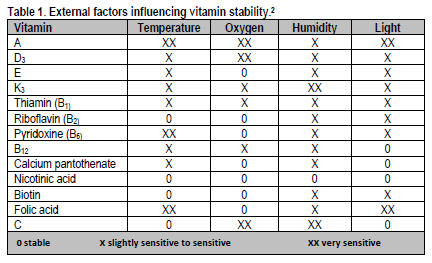Limiting vitamin storage time and ensuring vitamins are stored in cool, dry and dark locations is therefore critical for improved vitamin stability.
2. Separate Vitamin and Mineral Premixes
Premixes often contain ingredients like choline chloride and/or inorganic trace minerals such as Fe, Cu, Zn, etc. which are required for metabolism and efficient nutrient utilization. However, mixing these ingredients with vitamins can have an aggressive effect on vitamin susceptibility to destruction via oxidation.5,6 For example, average monthly loss of Vitamin A was found to be 9 percent greater in a vitamin and inorganic trace mineral premix compared to a vitamin premix.6 Separating vitamins from “reactive” premix ingredients can help reduce potential vitamin activity loss and improve vitamin storage stability.
3. Avoid Feeding Oxidized Fats and Oils
In one month’s time, vitamin retention in feed typically decreases 2-4 percent. However, the presence of poor-quality ingredients such as oxidized fats, can increase the susceptibility of vitamins to oxidation. Specifically, Vitamin A – which contains five double bonds – is highly prone to destruction via toxic free radicals and peroxides produced during autooxidation of fats and oils. Because of its susceptibility to oxidation, Vitamin A is frequently used as a marker of vitamin activity loss in premixes and feed.
Vitamin E – a natural antioxidant – plays a critical role in managing free radicals produced during regular cellular processes. Deficiency in Vitamin E has been linked to increased susceptibility of animals to diseases associated with oxidative stress such as Mulberry Heart Disease in swine.7 Further, a recent meta-analysis showed that feeding diets containing peroxidized lipids can decrease Vitamin E concentrations by 50 percent in both the serum and the liver of monogastric animals.8 Therefore, ensuring supplemental fats and oils are not oxidized, or using fat sources stabilized with antioxidants, is critical to ensure your animals receive adequate levels of vitamins needed for optimal health and performance.
4. Feed Manufacturing Processes Matter
Feed manufacturing processes which expose feed and labile ingredients, like vitamins, to extreme conditions – i.e. pellet conditioning, extrusion and expansion – can be critical factors responsible for vitamin degradation. For example, over 3 months of storage, Vitamin E levels in pelleted broiler feed and expanded pig diets decreased to 46 percent and 53 percent of their initial values, respectively.9 In contrast, Vitamin E levels in untreated diets only showed decreases to 62 percent and 74 percent of their initial values, respectively.9
During conditioning, ingredients experience significant heat, moisture, pressure and friction which can soften vitamin coating, making it easier for oxygen to access and degrade vitamins. While longer conditioning times can improve feed ingredient digestibility and pellet quality, it’s important to remember that vitamins exposed to these extreme conditions will be more susceptible to destruction.
5. Don’t Forget the Impact of Environmental Stress and Disease
Environmental stress and disease conditions can have a significant impact on an animal’s basic vitamin requirements. Reduction in feed intake – due to heat stress or disease – can lead to vitamin deficiency. During a vitamin deficient state, animals must prioritize use of nutrients to support the demands of immunological responses to disease, thereby leaving insufficient vitamins available to support growth.
Damage to the gastrointestinal tract also puts livestock and poultry at risk of vitamin deficiency due to reduced vitamin absorption. For example, in poultry, damage to the intestinal epithelia tissue by coccidia parasites can hinder absorption of nutrients – like vitamins and fats – resulting in vitamin deficiency and increased disease severity.10 Mycotoxins have also been linked to intestinal barrier damage resulting in leaky gut syndrome and nutrient malabsorption.11,12 So, it’s important to remember that managing stress and disease is critical to a healthy gut, which is required for proper absorption and utilization of vitamins in livestock and poultry.
Summary
Losses in vitamin activity may lead to subclinical vitamin deficiencies, thereby reducing animal health and efficiency. By minimizing storage time, separating vitamin and mineral premixes, avoiding use of oxidized oils and fats, limiting exposure to extreme conditions during feed manufacturing and controlling environmental stress and disease, you can help reduce vitamin susceptibility to destruction thereby supporting your livestock and poultry’s optimal performance.
For more information on how Kemin Animal Nutrition and Health can help you prevent vitamin loss in premixes and complete feed, please visit kemin.com/endox-dry.
References
1Marks, J. 1979. A guide to the vitamins: their role in health and disease. Published by MTP, Medical and Technical Publishing Co., Ltd., England.
2DSM. Factors affecting vitamin requirements and vitamin utilization. https://www.dsm.com/markets/anh/en_US/Compendium/vitamin_basics/factors_affecting_vitamin_requirements_and_vitamin_utilization.html. Accessed on March 4, 2020.
3Mavromichalis, I. 2015. Understanding vitamin stability in animal feed premixes. Feed Strategy. https://www.feedstrategy.com/animal-feed-manufacturing/understanding-vitamin-stability-in-animal-feed-premixes/. Accessed on March 4, 2020.
4Gadient, M. 1986. Effect of pelleting on nutritional quality of feed. In: Maryland Nutrition Conference Proceedings, College Park, MD, p.73.
5Yang, P., et al. (2019). Effects of Choline Chloride, Copper Sulfate and Zinc Oxide on Long-Term Stabilization of Microencapsulated Vitamins in Premixes for Weanling Piglets. Animals, 9:1154-1176.
6Shurson, G. et al. (2011). Effect of metal specific amino acid complexes and inorganic trace minerals on vitamin stability in premixes. Animal Feed Science and Technology, 163:200-206.
7Mulberry Heart Disease (vitamin E deficiency): https://thepigsite.com/disease-guide/mulberry-heart-disease-vitamin-e-deficiency. Accessed on January 15, 2020.
8Hung, Y. T. et al. (2017). Peroxidized lipids reduce growth performance of poultry and swine: A meta-analysis. Animal Feed Science and Technology, 231:47-58.
9Kostadinović, L.M. et al. (2013). Effect of pelleting and expanding processes on stability of Vitamin E in animal feeds. Food and Feed Research, 40(2):109-114.
10Jarujareet, W. et al. (2018). Eimeria tenella oocyst excretion and riboflavin supplement in infected chicken. Journal of Veterinary Medical Science, 80(9):1392-1394.
11Wan, L.Y.M., P.C. Turner, and H. El-Nezami. (2013). Individual and combined cytotoxic effects of Fusarium toxins (deoxynivalenol, nivalenol, zearalenone and fumonisin B1) on swine jejunal epithelial cells. Food and Chemical Toxicology, 57:276-283.
12Akbari, P., et al. (2017). The intestinal barrier as an emerging target in the toxicological assessment of mycotoxins. Arch. Toxicol., 91:1007-1029.


